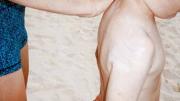A lotion that tans your skin without exposure to the sun and protects you against skin cancer sounds like the sort of miracle product you’d hear about on a late-night television commercial. But this dream cream is no scam.
In a study described in Nature last fall, David E. Fisher, director of the melanoma program at Dana-Farber Cancer Institute and a professor of pediatrics at Harvard Medical School, treated mice with a lotion that triggers a pigment-producing cycle in their cells. Unlike the sunless tanning products currently on the market, which simply “paint on” a darker color, the cream increased the production of melanin, the pigment that darkens skin and protects it from ultraviolet (UV) rays—even in a lab strain of “redhead” mice genetically engineered to be fair.
The more lotion was rubbed on the mice, the darker they became. The tan of the treated mice was indistinguishable under a microscope from a natural tan, and faded after a few weeks just as natural tans do.
Fisher’s research has transformed scientists’ understanding of the biology of tanning. Previously, UV rays were thought to penetrate the skin to the base of the epidermis, acting directly on the nucleus of the pigment-producing cells known as melanocytes and causing damage to their DNA.
Fisher found, however, that the UV rays are acting on different cells—not on the melanocytes, but on the keratinocytes, the most superficial skin cells, which represent more than 90 percent of the cells in the skin. The keratinocytes then produce and release a hormone that attaches to the exterior of melanocytes, thereby triggering the production of melanin.
In redhead mice that don’t normally tan, however, Fisher discovered that the receptors on the melanocytes’ surface do not respond to the keratinocyte-derived hormone. That finding allowed him to trigger the tanning process in a different way, by using the topically delivered drug to bypass the defective receptors and directly stimulate the production of melanin in the mice.
If the lotion works on humans as it does on mice, even the fairest of redheads will be able to acquire that sought-after suntanned look without risking the blistering burns that can come from sun exposure. And pasty Northerners without the time for a February jaunt to Aruba can get a safe mid-winter bronze instead of resorting to damaging tanning salons.
Despite the cream’s obvious cosmetic appeal, its medical implications are what excite Fisher, the study’s senior author. The deadliest form of skin cancer, malignant melanoma, is closely associated with the amount of pigment in a person’s skin, he says. Giving fair-skinned individuals a way to tan without sun exposure (which is associated with the more common forms of skin cancer) would have an important impact on public health.
Melanoma has been on the rise during the past 30 years. It accounts for 62,000 new cancer cases and 8,000 deaths annually in the United States, and differs from other skin cancers, Fisher says, because the risk does not decrease with sunscreen use. He is testing the hypothesis that using too much sunscreen and staying too pale may actually increase the risk of melanoma—a controversial idea that runs counter to current conventional wisdom.
“There are a lot of people out there—good parents who have absolutely the best intentions for their children—who buy SPF 50 sunscreen. They lather it on their kids and say, ‘Look, this child is as pale as a ghost. We did a good job,’” Fisher says. In fact, he warns, that practice can be “dangerous” because it keeps those children very pale. The opposite approach—giving children unprotected sun exposure so they develop UV-protective tans—is also harmful, because it will increase their risk of basal cell carcinoma and squamous cell carcinoma, two of the most common forms of skin cancer.
Is there a happy medium? If the cream Fisher used on mice can be applied to humans, there may be. People could use it to protect against melanoma by increasing their pigmentation, he says, while continuing to use sunscreen to protect against other forms of skin cancer.
It will be a few years before Fisher and his team are ready to test their product on people. Now they are testing it on lab samples (discarded after surgeries) of human skin, which is three to five times thicker than the skin of a mouse. “If we can achieve a result in [human] skin,” Fisher says, “it’s very likely [the cream] will work on a real person.”
~Samantha Henig
David Fisher e-mail address: david_fisher@dfci.harvard.edu
David Fisher website: https://research.dfci.harvard.edu/fisherlab





